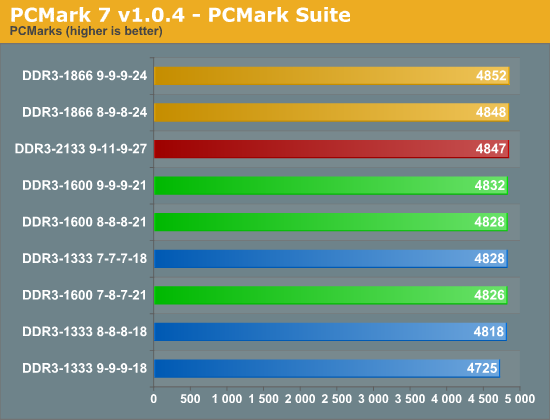Sandy Bridge Memory Scaling: Choosing the Best DDR3
by Jared Bell on July 25, 2011 1:55 AM ESTLINPACK Benchmark
At first I wasn't going to include the results of the LINPACK benchmark, but I figured there's no reason for them to go to waste as they were used for stability testing. The LINPACK benchmark is a measurement of a system's floating-point computing power. Today, it's widely used by enthusiasts for testing the stability of their overclocked systems. The later versions of LINPACK include support for Intel's AVX instruction set, which stress the CPU and RAM even more than before. We'll be using a front end to the LINPACK benchmark called LinX.

Now we begin to see how that extra ~36% of bandwidth really affects system performance. As you can see, there's not exactly a ~36% advantage in LINPACK from the fastest to the slowest. Here, we're barely seeing a ~3% advantage for the faster memory. Once we get to DDR3-1600, there's not much of a difference at all.
PCMark 7
We'll measure overall system performance using the PCMark suite. This will perform a broad range of tests including video playback, video transcoding (downscaling), system storage (gaming), graphics (DX9), image manipulation, system storage (importing pictures), web browsing, data decrypting, and system storage (Windows Defender).

If you take a step back and look at performance from an overall perspective, you can see that faster memory doesn't really have much of an effect. Every speed tested shows a ~2% performance increase over the slowest memory. Outside of CAS 9 DDR3-1333, then, you can pretty much use any DDR3 memory and get close to optimal performance in general applications.










76 Comments
View All Comments
dfjgkheu - Tuesday, July 26, 2011 - link
believe you will love it.====( www )( bestniceshoes)( c o m ) ====
The website whol esale for many kinds of fashion shoes,
like the ni ke, jor dan, pra da, also including the jea ns,shirts,bags,hat and the decorations.
All the products are free ship ping, and the the price is competitive,
and also can accept the pay pal payment.
,after the payment, can ship within short time
vailr - Monday, July 25, 2011 - link
No discussion of differing voltages?A quick check for DDR3 at Newegg shows:
G.SKILL ECO Series 4GB (2 x 2GB) 240-Pin DDR3 SDRAM DDR3 1600
@ 1.35 volts & Cas Latency: 7
vs.
G.SKILL Ripjaws X Series 4GB (2 x 2GB) 240-Pin DDR3 SDRAM DDR3 1600
@ 1.50 volts & Cas Latency: 6
A more thorough consideration of these two DDR3 modules might be interesting.
For virtually the same money, aren't most people going to seek out DDR3 with the lowest possible CAS latency number, and also combined with the lowest possible voltage design?
I know that: I wouldn't consider buying any DDR3 memory modules with a (nominal) CAS latency higher than 7.
JarredWalton - Monday, July 25, 2011 - link
Just as we didn't test with ten different modules (for ease of testing), we didn't use different voltage memory. Whether your RAM is 1.5V or 1.35V, at the same timings and speed the performance should be identical (less than a 0.5% difference). And we did look at the effect of lower latency RAM; sure, at the same price buy lower latency and higher bandwidth RAM, but prices aren't the same, particularly on 2x4GB kits.Tchamber - Monday, July 25, 2011 - link
I'd like to see how these tests stack up against the tripple channel nehalem i7's.duploxxx - Monday, July 25, 2011 - link
compare with what an EOL platform? it was alreay known that there is no added value with memory speed testing on these systems, just like the previous gen., 1366 is dead testing has been done in the pastThis test just showed that it is a lot of wasted money and time investigated in this.
They better take the time and investigate further into Liano memory speed, something that really does scale with memory.
Finally - Monday, July 25, 2011 - link
It's already done, see Computerbase...JarredWalton - Monday, July 25, 2011 - link
We've done it as well for graphics applications:http://www.anandtech.com/show/4476/amd-a83850-revi...
We haven't done the application testing with different DDR3 on Llano, however.
banwell - Monday, July 25, 2011 - link
You can also get a nice 'free' bump in performance at 1600 by switching to 1T. Something the better quality memory will be able to do easily.AssBall - Monday, July 25, 2011 - link
I'm not sure why they didn't test 1T . It is a memory scaling article after all. Anyway TechReport did and their conclusions are about the same, I.E. unless you are overclocking and running synthetic benchmarks, it doesn't really matter.compudaze - Monday, July 25, 2011 - link
Lowering the command rate from 2T to 1T at DDR3-1600 doesn't necessarily mean you can do the same at DDR3-2133. Not all memory modules, CPU's and motherboards are creased equal. Testing all configurations at 2T kept the results comparable.